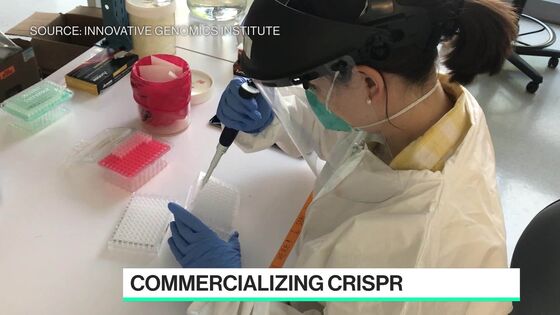Crispr Pioneer Expects to See Gene-Edited Babies Within 25 Years
Crispr Pioneer Expects to See Gene-Edited Babies Within 25 Years
(Bloomberg) -- It’s been 10 years since Crispr pioneer Jennifer Doudna published the landmark paper that landed a Nobel Prize for her and colleague Emmanuelle Charpentier, and the researcher already sees advancement toward some of its loftier goals.
To some, the Crispr future has been disappointingly slow to develop. But scientists around the world are using the technology to develop potential cures for debilitating genetic conditions, create diagnostic tests, produce better crops and fight climate change. And editing the genes of babies, a controversial practice Doudna was “horrified” by when a Chinese scientist revealed he’d changed the genomes of twin girls, may arrive within our lifetimes, she said.

Bloomberg News spoke with Doudna, a University of California at Berkeley biochemist and founder of the Innovative Genomics Institute, about the progress Crispr has made and where it can still go. The interview has been edited for clarity and length.
Bloomberg: A few years ago, everyone was talking about editing the genomes of babies using Crispr after a scientist said he had done just that. What has been the ramification of that experience, and have you seen any new developments?
A: There was a big flurry of attention around Crispr babies when that work was first announced in late 2018. We just had an international summit that was held virtually, and I noticed it wasn’t particularly well attended. I don’t know if it’s because people are more comfortable with Crispr babies – I don’t think that’s true – but it may say there’s not as much concern that this is an immediate threat of some kind.

Bloomberg: Have you seen any change in people’s stance?
A: Based on what I saw at this international summit, there’s an increasing comfort in a way, at least with using Crispr experimentally, not for creating Crispr-edited babies, but for understanding human development, and that means doing experiments in early embryos and in germ cells. In the early days, there were people who would say, “Wait, wait, wait, we can’t do that. That’s just got to be off limits.” And increasingly, that doesn’t even come up. There’s sort of an assumption that, yeah, that’s going to get done. It’s more a question of, how do we do it? How do we control it? How do we regulate it? Who decides who’s doing it? How do we pay for it? That kind of thing.
Bloomberg: In our lifetimes, will we see Crispr-edited babies?
A: Over the next 25 years, it’s entirely possible. When I think about 25 years ago and how much progress has been made, that’s extraordinary. I don’t imagine things are going to be slowing down from here, then it’s probably a very real possibility. [In an email following the interview, Doudna said she is “not advocating for human germline editing, simply stating that it is likely to happen in the next 25 years given the direction of research and technology development.”]
Bloomberg: How far has Crispr come in the past decade? Were the expectations unfairly high?
A: It often takes decades for a new technology to really start to impact the whole research landscape or actual applications. It’s extraordinary that Crispr within a decade is already there. Is there more work to be done? Of course. There’s always more.
Bloomberg: Where might Crispr not work?
A: It’s more of a degree of difficulty. I don’t think anyone’s found a cell type or a system where it just doesn’t work. There would be a lot of interest in using it for targeting cancer, but you’d have to be able to target tumor cells pretty accurately. That’s just a big challenge. There could be a lot of benefit to editing the heart muscle or the lung. There’s been a lot less work done on how to deliver Crispr into those tissue types.
Bloomberg: Do the Crispr-Cas9 patents matter anymore given all the new systems that are being developed?
A: That’s certainly a question for a good patent attorney.
Bloomberg: Do you have any thoughts on that?
A: It’s been interesting that with the patent dispute going on in the background, it certainly hasn’t slowed any of that down. There’s companies getting started all the time, lots of investors putting money into the space, lots and lots and lots of academic research going on. I can’t even keep up with all the academic publications that are coming out every single day. It’s important for people to understand there’s a lot of noise about the patent dispute, but in the end I don’t see it hindering the progress.
Bloomberg: What should people expect to see from Crispr in the next 5 to 10 years?
A: We’ll see Crispr-edited plants and crops, Crispr being used diagnostically and for preventive medicine. I imagine a future where you have your DNA sequenced, you identify the APOE4 allele that makes you susceptible to Alzheimer’s disease and you can use a Crispr strategy to flip that switch and put you back to an allele that is more protective against Alzheimer’s. That’s not happening next year, but in the next 25 years could that happen? Yeah, it could.
©2022 Bloomberg L.P.